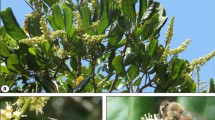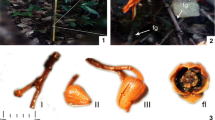Abstract
Staminodes are floral structures occurring in approximately one-third of the angiosperms. These organs often go unnoticed in nature because they may mimic other floral parts. Consequently, their macro- and micromorphological portrayal in the literature is limited. This study presents a detailed descriptive account of staminodes in the Cactaceae, specifically the Plains Prickly Pear, Opuntia polyacantha Haw., a species with both regular (lacking staminodes) and staminodial flowers. We present the first morphological overview of staminodes in the Cactaceae, rendering a wider perception of the variability in patterns of floral parts in this plant group. Light and scanning electron microscopy revealed that staminodes are complex parts located in the middle and outer androecial whorls and display a wide diversity of shapes and sizes. These staminodes (resembling either stamens or tepals) are considered transitional organs deriving from fertile stamens along the androecial margins via a series of transformations involving gradual widening and amalgamation with tepals. Unlike the typical dysfunctional angiosperm staminodes, pollen viability counts showed that some O. polyacantha staminodes produce fertile pollen similar in shape and size to regular stamens. The staminodes boost an increase in floral size and diameter in relation to non-staminodial flowers. Thus, larger flower diameter and landing platform combined with added viable pollen from staminodes promote visual attraction for pollinators and reproductive assurance. Because of the presence of fertile pollen, broadening the meaning of the term staminode is discussed along with the putative origin of these appendages.






Similar content being viewed by others
References
Almeida OJG, Paoli AAS, Cota-Sánchez JH (2012) A macro- and micromorphological survey of floral and extrafloral nectaries in the epiphytic cactus Rhipsalis teres (Cactoideae: Rhipsalideae). Flora 207:119–125
Almeida OJG, Souza LA, Paoli AAS, Davis AR, Cota-Sánchez JH (2018) Pericarp development in fruit of epiphytic cacti: implications for fruit classification and macro-morphology in the Cactaceae. Botany 96:621–635
Anderson EF (2001) The cactus family. Timber Press Inc, Portland
Appleton AD, Schenk JJ (2021) Evolution and development of staminodes in Paronychia (Caryophyllaceae). Int J Plant Sci 182:377–388
Backeberg HV (1958) Die Cactaceae, Vol.1: I-VI, 35 pl. VEB Gustav Fischer, Verlag, Berlin
Barthlott W, Hunt DR (1993) Cactaceae. In: Kubitzki K, Rohwer JG, Bittrich V (eds) The families and genera of vascular plants, vol 2. Springer-Verlag, Berlin, pp 161–197
Bates D, Mächler M, Bolker B, Walker S (2014) Fitting linear mixed-effects models using lme4. arXiv preprint https://arxiv.org/abs/1406.5823
Botnaru L, Schenk JJ (2019) Staminode evolution in Mentzelia section Bartonia (Loasaceae) and its impact on insect visitation rates. Bot J Linn Soc 190:151–164
Braun PJ (1988) On the taxonomy of Brazilian Cereeae (Cactaceae). Bradleya 6:85–99
Bravo-Hollis H (1978) Las cactáceas de México, vol 1. Universidad Nacional Autónoma de México, México
Brockington SF, Alexandre R, Ramdial J, Moore MJ, Crawley S, Dhingra A, Hilu K, Soltis DE, Soltis PS (2009) Phylogeny of the Caryophyllales sensu lato: revisiting hypotheses on pollination biology and perianth differentiation in the core Caryophyllales. Int J Plant Sci 170:627–643
Brockington S, Dos Santos P, Glover B, Ronse De Craene L (2013) Androecial evolution in Caryophyllales in light of a parahyletic Molluginaceae. Am J Bot 100:1757–1778
Buxbaum F (1950) Morphology of cacti. Section II: flower. Abbey Garden Press, Pasadena, pp 93–170
Cota-Sánchez JH (2002) Taxonomy, distribution, rarity status and uses of Canadian cacti. Haseltonia 9:17–25
Cota-Sánchez JH, Almeida OJG, Falconer DJ, Choi HJ, Bevan L (2013) Intriguing thigmonastic (sensitive ) stamens in the Plains Prickly Pear Opuntia polyacantha (Cactaceae). Flora 208:381–389
de Carvalho JDT, de Oliveira JMS (2021) Structural anomalies in pollen grains of Dyckia racinae L.B.Sm. (Bromeliaceae). Braz J Bot 44:179–185
Díaz L, Cocucci AA (2003) Functional gynodioecy in Opuntia quimilo (Cactaceae), a tree cactus pollinated by bees and hummingbirds. Plant Biol 5:531–539
Ellis B, Daly DC, Hickey LJ, Johnson KR, Mitchell JD, Wilf P, Wing SL (2009) Manual of leaf architecture. Cornell University Press, Ithaca, NY
Endress PK (2001) Origins of flower morphology. J Exp Zool 291:105–115
Endress PK (2006) Angiosperm floral evolution: morphological developmental framework. Adv Bot Res 44:1–61
Endress PK, Matthews ML (2006) Elaborate petals and staminodes in eudicots: diversity, function, and evolution. Org Divers Evol 6:257–293
Garralla S, Cuadrado GA (2007) Pollen morphology of Austrocylindropuntia Backeb, Maihueniopsis Speg., Opuntia Mill. and Tephrocactus Lem. (Cactaceae, Opuntioideae) of Argentina. Rev Palaeobot Palynol 146:1–17
Gonçalves-Esteves V, Cartaxo-Pinto S, Marinho EB, Esteves RL, Mendonça CBF (2021) Pollen morphology and evolutionary history of Sapindales. Braz J Bot. https://doi.org/10.1007/s40415-021-00719-7
González VV, Gorostiague P, Ortega-Baes P, Galati BG, Ferrucci MS (2021) Nectary structure is not related to pollination system in Trichocereeae cactus from Northwest Argentina. An Acad Bras Cienc 93:S4. https://doi.org/10.1590/0001-3765202120201401
Goto K, Kyozuka J, Bowman JL (2001) Turning floral organs into leaves, leaves into floral organs. Curr Opin Genet Dev 11:449–456
Gross CL (1993) The breeding system and pollinators of Melastoma affine (Melastomataceae); a pioneer shrub in tropical Australia. Biotropica 25:468–474
Gutiérrez-Flores C, Cota-Sánchez JH, León-de la Luz JL, García-De León FJ (2017) Disparity in floral traits and breeding systems in the iconic columnar cactus Pachycereus pringlei (Cactaceae). Flora 235:18–28
Hartmann HEK (1993) Aizoaceae. In: Kubitzki K, Rohwer JG, Bittrich V (eds) The families and genera of vascular plants, vol 2. Springer, Berlin, pp 37–69
Hernández-Cruz R, Silva-Martínez J, García-Campusano F, Cruz-García F, Orozco-Arroyo G, Alfaro I, Vázquez-Santana S (2019) Comparative development of staminate and pistillate flowers in the dioecious cactus Opuntia robusta. Plant Reprod 32:257–273
Hufford L (2003) Homology and developmental transformation: models for the origins of the staminodes of Loasaceae subfamily Loasoideae. Int J Plant Sci 164:S409–S439
Huynh KL (1983) Carpellodes or staminodes? Problems in the genus Pandanus (Pandanaceae), and their taxonomic significance. Bot J Linn Soc 87:177–192
Hrycan WC, Davis AR (2005) Comparative structure and pollen production of the stamens and pollinator-deceptive staminodes of Commelina coelestis and C. dianthifolia (Commelinaceae). Ann Bot 95:1113–1130
Kebert T (2014) Floral diagram generator. http://kvetnidiagram.8u.cz/index_en.php
Kiesling R (1980) Gymnocalycium mesopotamicum sp. nov. Cact Succ J (Great Britain) 42:39–42
Kirchoff BK (1991) Homeosis in the flowers of the Zingiberales. Am J Bot 78:833–837
Kozar F (1974) Ultrastructure of pollen of Opuntia polyacantha. Can J Bot 52:313–315
Kurtz EB (1948) Pollen grain characters of certain Cactaceae. Bull Torrey Bot Club 75:516–522
Kurtz EB (1963) Pollen morphology of the Cactaceae. Grana 4:367–372
Leins P, Erbar C (2010) Flower and fruit: morphology, ontogeny, phylogeny, function and ecology. Schweizerbart Science Publishers, Stuttgart
Leuenberger BE (1986) Pereskia (Cactaceae). Mem New York Bot Gard 41:1–141
Li X (2011) Pollen fertility/viability assay using FDA staining. https://bio-protocol.org/bio101/e75
Mayer SS, Charlesworth D (1991) Cryptic dioecy in flowering plants. Trends Ecol Evol 6:320–325
McFarland JD, Kevan PG, Lane MA (1989) Pollination biology of Opuntia imbricata (Cactaceae) in southern Colorado. Can J Bot 67:24–28
Meaders C, Min Y, Freedberg KJ, Kramer E (2020) Developmental and molecular characterization of novel staminodes in Aquilegia. Ann Bot 126:231–243
Orozco-Arroyo G, Vázquez-Santana S, Camacho A, Dubrovsky JG, Cruz-García F (2012) Inception of maleness: auxin contribution to flower masculinization in the dioecious cactus Opuntia stenopetala. Planta 236:225–238
Osborn MM, Kevan PG, Lane MA (1988) Pollination biology of Opuntia polyacantha and Opuntia phaeacantha (Cactaceae) in southern Colorado. Plant Syst Evol 159:85–94
Pin A (1998) Nota sobre dos especies de Brasiliopuntia (Cactaceae): B. schulzii y B. brasiliensis. Rojasiana 4:144–163
R Core Team (2020) R: A language and environment for statistical computing. R Foundation for Statistical Computing. Vienna, Austria. https://www.R-project.org
Reyes-Agüero JA, Aguirre JR, Valiente-Banuet A (2006) Reproductive biology of Opuntia: a review. J Arid Environ 64:549–585
Ronse De Craene LP (2003) The evolutionary significance of homeosis in flowers: a morphological perspective. Int J Plant Sci 164:S225–S235
Ronse De Craene LP (2008) Homology and evolution of petals in the core eudicots. Syst Bot 33:301–325
Ronse De Craene LP (2013) Reevaluation of the perianth and androecium in Caryophyllales: implications for flower evolution. Plant Syst Evol 299:1599–1636
Ronse De Craene LP, Brockington SF (2013) Origin and evolution of petals in angiosperms. Plant Ecol Evol 146:5–25
Ronse De Craene LP, Smets EF (2001) Staminodes: their morphological and evolutionary significance. Bot Rev 67:351–402
Ronse De Craene LP, Smets EF, Vanvinckenroye P (1998) Pseudodiplostemony, and its implications for the evolution of the androecium in the Caryophyllaceae. J Plant Res 111:25–43
Rueden CT, Schindelin J, Hiner MC, DeZonia BE, Walter AE, Arena ET, Eliceiri KW (2017) Image J2: ImageJ for the next generation of scientific image data. BMC Bioinformatics 18:529
Sandvik SM, Totland Ø (2003) Quantitative importance of staminodes for female reproductive success in Parnassia palustris under contrasting environmental conditions. Can J Bot 81:49–56
Schindelin J, Arganda-Carreras I, Frise E, Kaynig V, Longair M, Pietzsch T, Preibisch S, Rueden C, Saalfeld S, Schmid B, Tinevez J, White DJ, Hartenstein V, Eliceiri K, Tomancak P, Cardona A (2012) Fiji: an open-source platform for biological-image analysis. Nat Methods 9:676–682
Schlindwein C, Wittmann D (1997) Stamen movements in flowers of Opuntia (Cactaceae) favour oligolectic pollinators. Plant Syst Evol 204:179–193
Strittmatter LI, Hickey RJ, Negrón-Ortiz V (2008) Heterochrony and its role in sex determination of cryptically dioecious Consolea (Cactaceae) staminate flowers. Bot J Linn Soc 156:305–326
Strittmatter LI, Negrón-Ortiz V, Hickey RJ (2002) Subdioecy in Consolea spinosissima (Cactaceae): breeding system and embryological studies. Am J Bot 89:1373–1387
Verde GL, La Mantia T (2011) The role of native flower visitors in pollinating Opuntia ficus-indica (L.) Mill., naturalized in Sicily. Acta Oecol 37:413–417
Walker-Larsen J, Harder LD (2000) The evolution of staminodes in angiosperms: patterns of stamen reduction, loss, and functional re-invention. Am J Bot 87:1367–1384
Acknowledgements
We are indebted to the Plant Systematics personnel for critical comments on early drafts of the manuscript. Special thanks to Mr. Dewey Litwiller, and Mr. Guosheng Liu, and Mr. Marlynn Mierau for technical assistance.
Funding
Financial support for this study was made possible by the National Geographic Society (Grant No. 7382-02) and the University of Saskatchewan Tri-Council Bridge (Grant No. 411051) to JHCS.
Author information
Authors and Affiliations
Contributions
RSR conducted data collection, microscopic work, and preparation of figures of flowers and staminodes. RSR, DJF, and NAB carried out fieldwork and assisted with data collection. RVV conducted the statistical analyses and prepared related figures for the manuscript. JHCS conceived, designed, supervised, and validated the research. All authors contributed to discussions, writing of the manuscript, and read and approved the final document.
Corresponding author
Ethics declarations
Conflict of interest
J. Hugo Cota-Sánchez is Associate Editor of the Brazilian Journal of Botany, and this article was entirely handled by a different Associate Editor.
Additional information
Publisher's Note
Springer Nature remains neutral with regard to jurisdictional claims in published maps and institutional affiliations.
Rights and permissions
About this article
Cite this article
Rice, R.S., Vera-Vélez, R., Falconer, D.J. et al. Macro- and micromorphological characterization of staminodes in the Plains Prickly Pear Opuntia polyacantha Haw. (Cactaceae). Braz. J. Bot 45, 665–678 (2022). https://doi.org/10.1007/s40415-022-00790-8
Received:
Revised:
Accepted:
Published:
Issue Date:
DOI: https://doi.org/10.1007/s40415-022-00790-8




